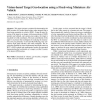Free Online Productivity Tools
i2Speak
i2Symbol
i2OCR
iTex2Img
iWeb2Print
iWeb2Shot
i2Type
iPdf2Split
iPdf2Merge
i2Bopomofo
i2Arabic
i2Style
i2Image
i2PDF
iLatex2Rtf
Sci2ools
JIRS
2006
2006
Vision-based Target Geo-location using a Fixed-wing Miniature Air Vehicle
This paper presents a method for determining the GPS location of a ground-based object when imaged from a fixed-wing miniature air vehicle (MAV). Using the pixel location of the target in an image, with measurements of MAV position and attitude, and camera pose angles, the target is localized in world coordinates. The main contribution of this paper is to present four techniques for reducing the localization error. In particular, we discuss RLS filtering, bias estimation, flight path selection, and wind estimation. The localization method has been implemented and flight tested on BYU's MAV testbed and experimental results are presented demonstrating the localization of a target to within 3 meters of its known GPS location. Key words. Unmanned air vehicles, geo-location, computer vision, micro air vehicles, localization
| Added | 13 Dec 2010 |
| Updated | 13 Dec 2010 |
| Type | Journal |
| Year | 2006 |
| Where | JIRS |
| Authors | D. Blake Barber, Joshua D. Redding, Timothy W. McLain, Randal W. Beard, Clark N. Taylor |
Comments (0)

